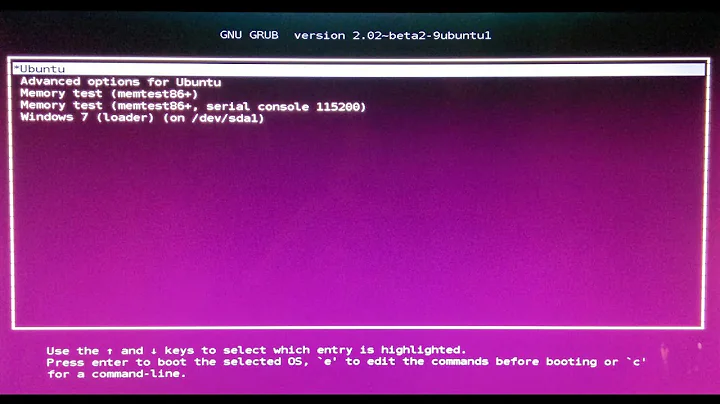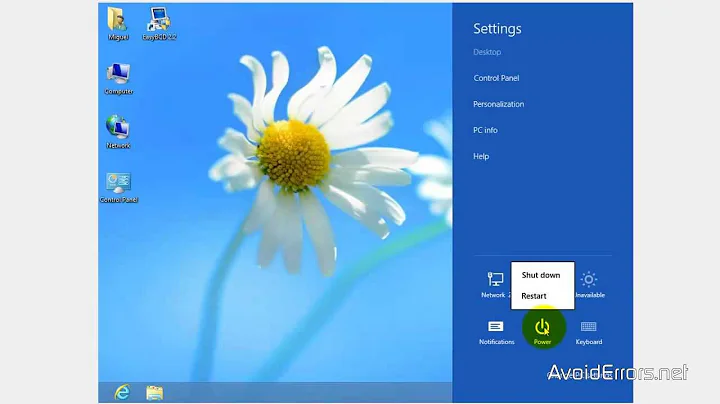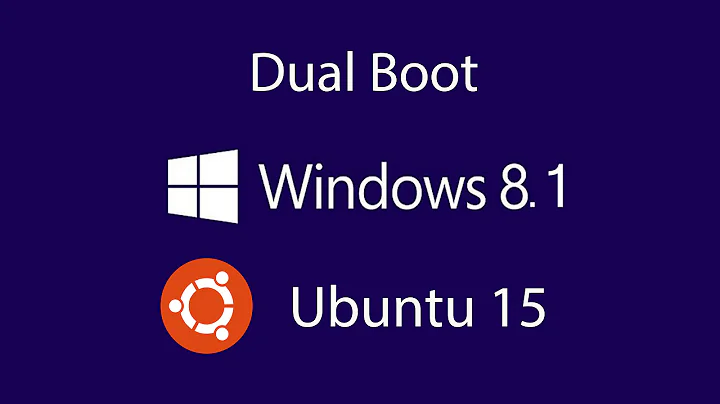Windows 8 doesn't allow Ubuntu start-up
Solution 1
It looks like you've got a BIOS-mode installation of Windows -- your disk is partitioned using the MBR scheme, not GPT as would be required for an EFI-mode installation; and there's a copy of the Windows boot loader in the MBR of the disk. It looks like you've got a reasonable grub.cfg file in your Linux partition, although I've not studied every last line of it; but it looks like something went wrong with the GRUB setup, since there's no trace of GRUB in the hard disk's MBR.
Chances are the Ubuntu Boot Repair tool will be able to get things working, although I can't promise that. If you run it and have problems, post back, since there are manual procedures that will almost certainly work, too.
Solution 2
it may be caused by many reasons but definitely not Windows 8 because I use both Win8 and Ubuntu 13.04
You may have a bad disk. If so, you need to set /boot as a separate partition(/dev/sda1) and put it at the head of the disk.
You may failed to install grub. if so, type grub-install /dev/sda in terminal in a livecd or try a software called "easybcd" under windows.
If your mbr was overwritten by Windows, you may just try sudo -i mount /dev/sda[#] /mnt grub-install --root-directory=/mnt/ /dev/sda in livecd. (/dev/sda[#] is where you / directory is)
hope you can solve your problem as soon as possible.
Related videos on Youtube
Rodrigo Martins de Oliveira
Hand drawings lover, fan of scifi space movies, opensource contributor and Software Engineering Manager @ QuintoAndar
Updated on September 18, 2022Comments
-
 Rodrigo Martins de Oliveira over 1 year
Rodrigo Martins de Oliveira over 1 yearScenario
Recently I build up my own desktop and decided to install as first OS Windows 8 (why did I do that...) as always I have both, Ubuntu and Windows, I though that installing Windows first would be better to check if my video card was working properly as drivers works better in Windows.
Problem
The problem is that when I installed Ubuntu after restarting the PC I won't be prompted to choose an OS, it simply starts Windows 8. Then I read about Windows 8 installation and found out that it uses UEFI boot as there is a partition created by Windows that is EFI.
Then I tried to install Ubuntu EFI although I got the very same situation. After that I did a last try making things manually by selecting the partition that Windows created as EFI partition, although the installation couldn't proceed because it didn't identified the EFI partition as an EFI partition.
What I want
I wonder if I delete the partition that Windows created as EFI and let Ubuntu create it's own EFI in the place will things work?
But if that isn't possible I don't want Windows 8 anymore in my PC, I will stick with 7 and Ubuntu, but as I don't know a lot about UEFI stuff I am wondering if I just make a backup partition for my important files in NTFS system and delete all the rest and then install Ubuntu and after Windows 7 it will work.
Because I don't know if Windows 8 configurations into the UEFI BIOS will remain after deleting it from the HDD and it will prevent me from installing other OS'es and then I will be with no computer at all.
In addition I would like to have Ubuntu and Windows 7 installed both as EFI systems if possible cause as far as I know it improves security (correct me if I am wrong) and my motherboard doesn't support Secure Boot it has any option about that in the BIOS and I ran
Confirm-SecureBootUEFIcommand in Windows that returned that my system doesn't support Secure Boot.My PC Specs
CORSAIR Vengeance LP 8GB (2 x 4GB) DDR3 1333 (PC3 10666) (CML8GX3M2A1333C9)
GIGABYTE Radeon HD 7970 3GB 384-bit GDDR5 PCI Express 3.0 x16 (GV-R797OC-3GD)
Intel Core i5-3570 Ivy Bridge 3.4GHz (3.8GHz Turbo) LGA 1155 77W Quad-Core (BX80637I53570)
GIGABYTE GA-B75M-D3H Dual-UEFI LGA 1155 Intel B75 HDMI SATA 6Gb/s USB 3.0 Micro ATX (GA-B75M-D3H)
Seagate Barracuda 1TB 7200 RPM 32MB Cache SATA 6.0Gb/s 3.5" (ST31000524AS)
Additional Info
As suggested by user Rod Smith I ran Boot Info Script in the live usb of raring daily build, the content of the file
RESULTS.txtis here:Boot Info Script 0.61 [1 April 2012] ============================= Boot Info Summary: =============================== => Windows is installed in the MBR of /dev/sda. => Syslinux MBR (4.04 and higher) is installed in the MBR of /dev/sdb. sda1: __________________________________________________________________________ File system: ntfs Boot sector type: Windows Vista/7: NTFS Boot sector info: No errors found in the Boot Parameter Block. Operating System: Boot files: /bootmgr /Boot/BCD sda2: __________________________________________________________________________ File system: ntfs Boot sector type: Windows Vista/7: NTFS Boot sector info: No errors found in the Boot Parameter Block. Operating System: Boot files: /bootmgr /Windows/System32/winload.exe sda3: __________________________________________________________________________ File system: ext4 Boot sector type: - Boot sector info: Operating System: Ubuntu 13.04 Boot files: /boot/grub/grub.cfg /etc/fstab sda4: __________________________________________________________________________ File system: swap Boot sector type: - Boot sector info: sdb1: __________________________________________________________________________ File system: vfat Boot sector type: SYSLINUX 4.04 2011-04-18 Boot sector info: Syslinux looks at sector 1628296 of /dev/sdb1 for its second stage. SYSLINUX is installed in the directory. The integrity check of the ADV area failed. No errors found in the Boot Parameter Block. Operating System: Boot files: /boot/grub/grub.cfg /syslinux/syslinux.cfg /efi/BOOT/grubx64.efi /ldlinux.sys ============================ Drive/Partition Info: ============================= Drive: sda _____________________________________________________________________ Disk /dev/sda: 1000.2 GB, 1000204886016 bytes 255 heads, 63 sectors/track, 121601 cylinders, total 1953525168 sectors Units = sectors of 1 * 512 = 512 bytes Sector size (logical/physical): 512 bytes / 512 bytes Partition Boot Start Sector End Sector # of Sectors Id System /dev/sda1 * 2,048 718,847 716,800 7 NTFS / exFAT / HPFS /dev/sda2 718,848 921,599,999 920,881,152 7 NTFS / exFAT / HPFS /dev/sda3 921,600,000 1,945,693,749 1,024,093,750 83 Linux /dev/sda4 1,945,694,208 1,953,523,711 7,829,504 82 Linux swap / Solaris Drive: sdb _____________________________________________________________________ Disk /dev/sdb: 4051 MB, 4051697152 bytes 125 heads, 62 sectors/track, 1021 cylinders, total 7913471 sectors Units = sectors of 1 * 512 = 512 bytes Sector size (logical/physical): 512 bytes / 512 bytes Partition Boot Start Sector End Sector # of Sectors Id System /dev/sdb1 * 62 7,912,749 7,912,688 b W95 FAT32 "blkid" output: ________________________________________________________________ Device UUID TYPE LABEL /dev/loop0 squashfs /dev/sda1 4664C9EB64C9DE35 ntfs Reservado pelo Sistema /dev/sda2 8A46D14C46D13A21 ntfs /dev/sda3 3372315d-d1df-4670-bcbb-4a4ab5548b09 ext4 /dev/sda4 d5f3ad90-fa34-4a62-9adc-efc3fdd3bfce swap /dev/sdb1 B656-E464 vfat MYLINUXLIVE ================================ Mount points: ================================= Device Mount_Point Type Options /dev/loop0 /rofs squashfs (ro,noatime) /dev/sda2 /media/ubuntu/8A46D14C46D13A21 fuseblk (rw,nosuid,nodev,allow_other,default_permissions,blksize=4096) /dev/sdb1 /cdrom vfat (ro,noatime,fmask=0022,dmask=0022,codepage=437,iocharset=iso8859-1,shortname=mixed,errors=remount-ro) =========================== sda3/boot/grub/grub.cfg: =========================== -------------------------------------------------------------------------------- # # DO NOT EDIT THIS FILE # # It is automatically generated by grub-mkconfig using templates # from /etc/grub.d and settings from /etc/default/grub # ### BEGIN /etc/grub.d/00_header ### if [ -s $prefix/grubenv ]; then set have_grubenv=true load_env fi set default="0" if [ x"${feature_menuentry_id}" = xy ]; then menuentry_id_option="--id" else menuentry_id_option="" fi export menuentry_id_option if [ "${prev_saved_entry}" ]; then set saved_entry="${prev_saved_entry}" save_env saved_entry set prev_saved_entry= save_env prev_saved_entry set boot_once=true fi function savedefault { if [ -z "${boot_once}" ]; then saved_entry="${chosen}" save_env saved_entry fi } function recordfail { set recordfail=1 if [ -n "${have_grubenv}" ]; then if [ -z "${boot_once}" ]; then save_env recordfail; fi; fi } function load_video { if [ x$feature_all_video_module = xy ]; then insmod all_video else insmod efi_gop insmod efi_uga insmod ieee1275_fb insmod vbe insmod vga insmod video_bochs insmod video_cirrus fi } if [ x$feature_default_font_path = xy ] ; then font=unicode else insmod part_msdos insmod ext2 set root='hd0,msdos3' if [ x$feature_platform_search_hint = xy ]; then search --no-floppy --fs-uuid --set=root --hint-bios=hd0,msdos3 --hint-efi=hd0,msdos3 --hint-baremetal=ahci0,msdos3 3372315d-d1df-4670-bcbb-4a4ab5548b09 else search --no-floppy --fs-uuid --set=root 3372315d-d1df-4670-bcbb-4a4ab5548b09 fi font="/usr/share/grub/unicode.pf2" fi if loadfont $font ; then set gfxmode=auto load_video insmod gfxterm set locale_dir=$prefix/locale set lang=pt_BR insmod gettext fi terminal_output gfxterm if [ "${recordfail}" = 1 ]; then set timeout=-1 else set timeout=10 fi ### END /etc/grub.d/00_header ### ### BEGIN /etc/grub.d/05_debian_theme ### set menu_color_normal=white/black set menu_color_highlight=black/light-gray if background_color 44,0,30; then clear fi ### END /etc/grub.d/05_debian_theme ### ### BEGIN /etc/grub.d/10_linux ### function gfxmode { set gfxpayload="${1}" if [ "${1}" = "keep" ]; then set vt_handoff=vt.handoff=7 else set vt_handoff= fi } if [ "${recordfail}" != 1 ]; then if [ -e ${prefix}/gfxblacklist.txt ]; then if hwmatch ${prefix}/gfxblacklist.txt 3; then if [ ${match} = 0 ]; then set linux_gfx_mode=keep else set linux_gfx_mode=text fi else set linux_gfx_mode=text fi else set linux_gfx_mode=keep fi else set linux_gfx_mode=text fi export linux_gfx_mode menuentry 'Ubuntu' --class ubuntu --class gnu-linux --class gnu --class os $menuentry_id_option 'gnulinux-simple-3372315d-d1df-4670-bcbb-4a4ab5548b09' { recordfail load_video gfxmode $linux_gfx_mode insmod gzio insmod part_msdos insmod ext2 set root='hd0,msdos3' if [ x$feature_platform_search_hint = xy ]; then search --no-floppy --fs-uuid --set=root --hint-bios=hd0,msdos3 --hint-efi=hd0,msdos3 --hint-baremetal=ahci0,msdos3 3372315d-d1df-4670-bcbb-4a4ab5548b09 else search --no-floppy --fs-uuid --set=root 3372315d-d1df-4670-bcbb-4a4ab5548b09 fi linux /boot/vmlinuz-3.8.0-19-generic root=UUID=3372315d-d1df-4670-bcbb-4a4ab5548b09 ro quiet splash $vt_handoff initrd /boot/initrd.img-3.8.0-19-generic } submenu 'Opções avançadas para Ubuntu' $menuentry_id_option 'gnulinux-advanced-3372315d-d1df-4670-bcbb-4a4ab5548b09' { menuentry 'Ubuntu, com Linux 3.8.0-19-generic' --class ubuntu --class gnu-linux --class gnu --class os $menuentry_id_option 'gnulinux-3.8.0-19-generic-advanced-3372315d-d1df-4670-bcbb-4a4ab5548b09' { recordfail load_video gfxmode $linux_gfx_mode insmod gzio insmod part_msdos insmod ext2 set root='hd0,msdos3' if [ x$feature_platform_search_hint = xy ]; then search --no-floppy --fs-uuid --set=root --hint-bios=hd0,msdos3 --hint-efi=hd0,msdos3 --hint-baremetal=ahci0,msdos3 3372315d-d1df-4670-bcbb-4a4ab5548b09 else search --no-floppy --fs-uuid --set=root 3372315d-d1df-4670-bcbb-4a4ab5548b09 fi echo 'Carregando Linux 3.8.0-19-generic ...' linux /boot/vmlinuz-3.8.0-19-generic root=UUID=3372315d-d1df-4670-bcbb-4a4ab5548b09 ro quiet splash $vt_handoff echo 'Carregando ramdisk inicial ...' initrd /boot/initrd.img-3.8.0-19-generic } menuentry 'Ubuntu, com Linux 3.8.0-19-generic (modo de recuperação)' --class ubuntu --class gnu-linux --class gnu --class os $menuentry_id_option 'gnulinux-3.8.0-19-generic-recovery-3372315d-d1df-4670-bcbb-4a4ab5548b09' { recordfail load_video insmod gzio insmod part_msdos insmod ext2 set root='hd0,msdos3' if [ x$feature_platform_search_hint = xy ]; then search --no-floppy --fs-uuid --set=root --hint-bios=hd0,msdos3 --hint-efi=hd0,msdos3 --hint-baremetal=ahci0,msdos3 3372315d-d1df-4670-bcbb-4a4ab5548b09 else search --no-floppy --fs-uuid --set=root 3372315d-d1df-4670-bcbb-4a4ab5548b09 fi echo 'Carregando Linux 3.8.0-19-generic ...' linux /boot/vmlinuz-3.8.0-19-generic root=UUID=3372315d-d1df-4670-bcbb-4a4ab5548b09 ro recovery nomodeset echo 'Carregando ramdisk inicial ...' initrd /boot/initrd.img-3.8.0-19-generic } } ### END /etc/grub.d/10_linux ### ### BEGIN /etc/grub.d/20_linux_xen ### ### END /etc/grub.d/20_linux_xen ### ### BEGIN /etc/grub.d/20_memtest86+ ### ### END /etc/grub.d/20_memtest86+ ### ### BEGIN /etc/grub.d/30_os-prober ### menuentry 'Windows 8 (loader) (em /dev/sda1)' --class windows --class os $menuentry_id_option 'osprober-chain-4664C9EB64C9DE35' { insmod part_msdos insmod ntfs set root='hd0,msdos1' if [ x$feature_platform_search_hint = xy ]; then search --no-floppy --fs-uuid --set=root --hint-bios=hd0,msdos1 --hint-efi=hd0,msdos1 --hint-baremetal=ahci0,msdos1 4664C9EB64C9DE35 else search --no-floppy --fs-uuid --set=root 4664C9EB64C9DE35 fi drivemap -s (hd0) ${root} chainloader +1 } ### END /etc/grub.d/30_os-prober ### ### BEGIN /etc/grub.d/30_uefi-firmware ### ### END /etc/grub.d/30_uefi-firmware ### ### BEGIN /etc/grub.d/40_custom ### # This file provides an easy way to add custom menu entries. Simply type the # menu entries you want to add after this comment. Be careful not to change # the 'exec tail' line above. ### END /etc/grub.d/40_custom ### ### BEGIN /etc/grub.d/41_custom ### if [ -f ${config_directory}/custom.cfg ]; then source ${config_directory}/custom.cfg elif [ -z "${config_directory}" -a -f $prefix/custom.cfg ]; then source $prefix/custom.cfg; fi ### END /etc/grub.d/41_custom ### -------------------------------------------------------------------------------- =============================== sda3/etc/fstab: ================================ -------------------------------------------------------------------------------- # /etc/fstab: static file system information. # # Use 'blkid' to print the universally unique identifier for a # device; this may be used with UUID= as a more robust way to name devices # that works even if disks are added and removed. See fstab(5). # # <file system> <mount point> <type> <options> <dump> <pass> # / was on /dev/sda3 during installation UUID=3372315d-d1df-4670-bcbb-4a4ab5548b09 / ext4 errors=remount-ro 0 1 # swap was on /dev/sda4 during installation UUID=d5f3ad90-fa34-4a62-9adc-efc3fdd3bfce none swap sw 0 0 -------------------------------------------------------------------------------- =================== sda3: Location of files loaded by Grub: ==================== GiB - GB File Fragment(s) = boot/grub/grub.cfg 1 = boot/initrd.img-3.8.0-19-generic 1 = boot/vmlinuz-3.8.0-19-generic 1 = initrd.img 1 = vmlinuz 1 =========================== sdb1/boot/grub/grub.cfg: =========================== -------------------------------------------------------------------------------- if loadfont /boot/grub/font.pf2 ; then set gfxmode=auto insmod efi_gop insmod efi_uga insmod gfxterm terminal_output gfxterm fi set menu_color_normal=white/black set menu_color_highlight=black/light-gray menuentry "Try Ubuntu without installing" { set gfxpayload=keep linux /casper/vmlinuz.efi file=/cdrom/preseed/ubuntu.seed boot=casper quiet splash -- initrd /casper/initrd.lz } menuentry "Install Ubuntu" { set gfxpayload=keep linux /casper/vmlinuz.efi file=/cdrom/preseed/ubuntu.seed boot=casper only-ubiquity quiet splash -- initrd /casper/initrd.lz } menuentry "OEM install (for manufacturers)" { set gfxpayload=keep linux /casper/vmlinuz.efi file=/cdrom/preseed/ubuntu.seed boot=casper only-ubiquity quiet splash oem-config/enable=true -- initrd /casper/initrd.lz } menuentry "Check disc for defects" { set gfxpayload=keep linux /casper/vmlinuz.efi boot=casper integrity-check quiet splash -- initrd /casper/initrd.lz } -------------------------------------------------------------------------------- ========================= sdb1/syslinux/syslinux.cfg: ========================== -------------------------------------------------------------------------------- # D-I config version 2.0 include menu.cfg default vesamenu.c32 prompt 0 timeout 50 ui gfxboot bootlogo -------------------------------------------------------------------------------- =================== sdb1: Location of files loaded by Grub: ==================== GiB - GB File Fragment(s) ?? = ?? boot/grub/grub.cfg 1 ================= sdb1: Location of files loaded by Syslinux: ================== GiB - GB File Fragment(s) ?? = ?? ldlinux.sys 1 ?? = ?? syslinux/chain.c32 1 ?? = ?? syslinux/gfxboot.c32 1 ?? = ?? syslinux/syslinux.cfg 1 ?? = ?? syslinux/vesamenu.c32 1 ============== sdb1: Version of COM32(R) files used by Syslinux: =============== syslinux/chain.c32 : COM32R module (v4.xx) syslinux/gfxboot.c32 : COM32R module (v4.xx) syslinux/vesamenu.c32 : COM32R module (v4.xx) =============================== StdErr Messages: =============================== awk: cmd. line:36: Math support is not compiled in awk: cmd. line:36: Math support is not compiled in awk: cmd. line:36: Math support is not compiled in awk: cmd. line:36: Math support is not compiled in awk: cmd. line:36: Math support is not compiled in /home/ubuntu/Documents/bootinfoscript: line 1646: [: 2.73495e+09: integer expression expected No volume groups found-
Rod Smith about 11 yearsPlease run the Boot Info Script (sourceforge.net/projects/bootinfoscript) from the Ubuntu "try before installing" mode. This will create a file called
RESULTS.txt. Post a link to this file here; it contains vital diagnostic information that's necessary to do more than speculate about causes. -
 Luis Alvarado about 11 yearsWith the new info provided, We can start looking for any issues with that hardware and Ubuntu. Thanks for the update Rodrigo.
Luis Alvarado about 11 yearsWith the new info provided, We can start looking for any issues with that hardware and Ubuntu. Thanks for the update Rodrigo. -
 Rodrigo Martins de Oliveira about 11 yearsYou're welcome, I just think that deleting my comment replying to @LovinBuntu wasn't right, so just stating here what was on the comment: I ran the Recommended Repair without internet connecting, so I didn't got any URL.
Rodrigo Martins de Oliveira about 11 yearsYou're welcome, I just think that deleting my comment replying to @LovinBuntu wasn't right, so just stating here what was on the comment: I ran the Recommended Repair without internet connecting, so I didn't got any URL. -
 Luis Alvarado about 10 yearsHi @RodrigoMartins I have updated the marked duplicate question with several steps to fix Dual Boot issues. This are tested and work correctly for cases like yours apply
Luis Alvarado about 10 yearsHi @RodrigoMartins I have updated the marked duplicate question with several steps to fix Dual Boot issues. This are tested and work correctly for cases like yours apply
-
 Rodrigo Martins de Oliveira about 11 yearsI didn't know about Ubuntu Boot Repair tool, although I used it and I got no results. It says in the log file that everything seems to be okay and then appears that boot was repaired, but I am still with the very same problems. If you can help me on the manual process that you sad I would be thanked.
Rodrigo Martins de Oliveira about 11 yearsI didn't know about Ubuntu Boot Repair tool, although I used it and I got no results. It says in the log file that everything seems to be okay and then appears that boot was repaired, but I am still with the very same problems. If you can help me on the manual process that you sad I would be thanked. -
Rod Smith about 11 yearsYou need to boot an Ubuntu emergency CD and use the
grub-installprogram. The procedure is detailed at help.ubuntu.com/community/Grub2/…. -
 Rodrigo Martins de Oliveira about 11 yearsI tried easybcd, athough it didn't solved anything, I tried to use grub-install /dev/sda and it lead me to a grub prompt at the boot of the pc, then I tried your 4th solution, that is written wrong or may be old, the correct code is here: help.ubuntu.com/community/Grub2/… and then after that I got at grub rescue prompt.
Rodrigo Martins de Oliveira about 11 yearsI tried easybcd, athough it didn't solved anything, I tried to use grub-install /dev/sda and it lead me to a grub prompt at the boot of the pc, then I tried your 4th solution, that is written wrong or may be old, the correct code is here: help.ubuntu.com/community/Grub2/… and then after that I got at grub rescue prompt. -
 Rodrigo Martins de Oliveira about 11 yearsI used grub-install as recommended and this lead me to a grub rescue at system start, then I was not even able to start Windows. So I used Boot-Repair and set it to restore MBR and now I am able to start Windows 8 again. So I came back to same situation where I started.
Rodrigo Martins de Oliveira about 11 yearsI used grub-install as recommended and this lead me to a grub rescue at system start, then I was not even able to start Windows. So I used Boot-Repair and set it to restore MBR and now I am able to start Windows 8 again. So I came back to same situation where I started. -
 Rodrigo Martins de Oliveira about 11 yearsHey, it kind of worked with Ubuntu 13.04! I downloaded it today in the hope that something changes, installed and again the very same problem, then I though let's give one more chance to Boot-Repair Tool, installed it into the LiveUSB and ran it, Two words: Just worked! Thanks @RodSmith !!!
Rodrigo Martins de Oliveira about 11 yearsHey, it kind of worked with Ubuntu 13.04! I downloaded it today in the hope that something changes, installed and again the very same problem, then I though let's give one more chance to Boot-Repair Tool, installed it into the LiveUSB and ran it, Two words: Just worked! Thanks @RodSmith !!!




